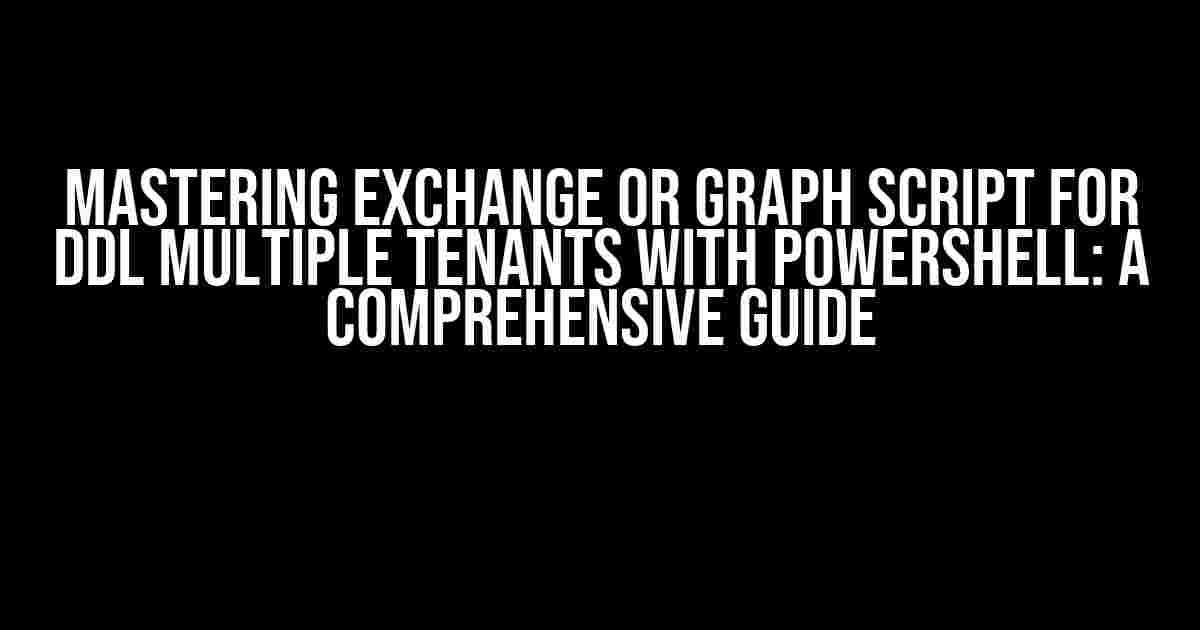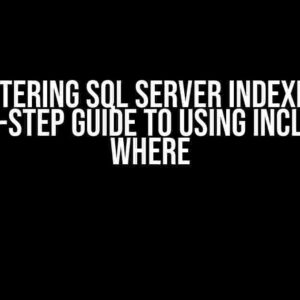Are you tired of manually managing multiple tenants on Exchange or Graph Script using the GUI? Do you want to automate tedious tasks and streamline your workflow? Look no further! In this article, we’ll dive into the world of PowerShell scripting for DDL multiple tenants and show you how to unlock the full potential of Exchange or Graph Script.
What is DDL and Why Do I Need It?
DDL (Delegate Delivery List) is a feature in Exchange that allows you to delegate mailbox access to specific users or groups. This feature is particularly useful in multi-tenant environments where you need to manage access to multiple mailboxes. However, managing DDL manually can be a daunting task, especially when dealing with multiple tenants.
That’s where PowerShell comes in – with the right scripts, you can automate DDL management, saving you time and effort. In this article, we’ll focus on creating an Exchange or Graph Script for DDL multiple tenants using PowerShell.
Prerequisites
Before we dive into the scripting, make sure you have the following prerequisites:
- Exchange Server 2013 or later (or Graph API)
- PowerShell 3.0 or later
- Exchange Management Shell (EMS) or Graph API permissions
- A good understanding of PowerShell basics
Understanding the Script
The script we’ll create will use the Exchange or Graph API to manage DDL for multiple tenants. We’ll use PowerShell to connect to the Exchange or Graph API, retrieve the list of tenants, and then apply the necessary changes to the DDL.
The script will consist of three main parts:
- Connecting to the Exchange or Graph API
- Retrieving the list of tenants
- Applying DDL changes to each tenant
Connecting to the Exchange or Graph API
To connect to the Exchange or Graph API, we’ll use the New-PSSession cmdlet. This cmdlet establishes a new PowerShell session with the Exchange or Graph API.
$Session = New-PSSession -ConfigurationName Microsoft.Exchange -ConnectionUri https://your_exchange_server/powershell
In the above code, replace https://your_exchange_server/powershell with the URL of your Exchange server or Graph API endpoint.
Retrieving the List of Tenants
Once connected, we’ll use the Get-Tenant cmdlet to retrieve the list of tenants.
$Tenants = Get-Tenant
The Get-Tenant cmdlet returns a list of tenant objects, which we’ll iterate through to apply the DDL changes.
Applying DDL Changes to Each Tenant
To apply DDL changes to each tenant, we’ll use the Set-Mailbox cmdlet. This cmdlet allows us to modify mailbox settings, including the DDL.
foreach ($Tenant in $Tenants) {
$Mailbox = Get-Mailbox -Identity $Tenant.TenantId
$DDL = $Mailbox.DisplayName + "\Delegate List"
Add-MailboxPermission -Identity $Mailbox.Identity -User $DDL -AccessRights FullAccess -InheritanceType All
}
In the above code, we iterate through the list of tenants and retrieve the corresponding mailbox object using the Get-Mailbox cmdlet. We then create a new DDL object with the tenant’s display name and add the necessary permissions using the Add-MailboxPermission cmdlet.
The Complete Script
Here’s the complete script:
# Connect to the Exchange or Graph API
$Session = New-PSSession -ConfigurationName Microsoft.Exchange -ConnectionUri https://your_exchange_server/powershell
Import-PSSession $Session
# Retrieve the list of tenants
$Tenants = Get-Tenant
# Apply DDL changes to each tenant
foreach ($Tenant in $Tenants) {
$Mailbox = Get-Mailbox -Identity $Tenant.TenantId
$DDL = $Mailbox.DisplayName + "\Delegate List"
Add-MailboxPermission -Identity $Mailbox.Identity -User $DDL -AccessRights FullAccess -InheritanceType All
}
# Remove the PowerShell session
Remove-PSSession $Session
Make sure to replace https://your_exchange_server/powershell with the URL of your Exchange server or Graph API endpoint.
Troubleshooting and Best Practices
When running the script, you may encounter some common issues:
| Error | Solution |
|---|---|
| Connection issue | Check the Exchange or Graph API URL and credentials |
| Tenant not found | Verify the tenant ID or display name |
| DDL already exists | Modify the script to update the existing DDL instead of creating a new one |
Some best practices to keep in mind:
- Use a dedicated PowerShell session for each Exchange or Graph API connection
- Test the script in a dev environment before running it in production
- Monitor the script’s performance and adjust the batch size accordingly
- Keep the script up-to-date with the latest Exchange or Graph API changes
Conclusion
In this article, we’ve demonstrated how to create an Exchange or Graph Script for DDL multiple tenants using PowerShell. By automating DDL management, you can save time, reduce errors, and improve your overall workflow.
Remember to customize the script to fit your specific needs and follow best practices to ensure smooth execution. With PowerShell and Exchange or Graph Script, the possibilities are endless!
Happy scripting!
Frequently Asked Questions
Got queries about Exchange or Graph Script for DDL multiple tenants Powershell? We’ve got the answers!
What is the main purpose of using an Exchange or Graph Script for DDL multiple tenants in Powershell?
The primary goal of using an Exchange or Graph Script for DDL multiple tenants in Powershell is to automate the process of creating, managing, and updating data definitions for multiple tenants in a single script. This enables administrators to efficiently manage large-scale deployments and ensure consistency across tenants.
How does the script handle differences in tenant configurations?
The script is designed to accommodate differences in tenant configurations by using conditional statements and variables to adapt to unique settings for each tenant. This ensures that the script can be easily customized to fit the specific needs of each tenant, without requiring a separate script for each one.
Can the script be used for both Exchange and Graph API?
Yes, the script can be used for both Exchange and Graph API, as it is designed to be flexible and adaptable to various API endpoints. The script can be easily modified to switch between Exchange and Graph API, making it a versatile tool for administrators who need to manage multiple API environments.
What kind of data definitions can be managed using the script?
The script can be used to manage a wide range of data definitions, including but not limited to: mailbox settings, mail flow rules, transport rules, and permissions. The script can also be extended to manage other types of data definitions specific to each tenant’s needs.
Is the script compatible with PowerShell 5 and above?
Yes, the script is compatible with PowerShell 5 and above. It has been tested on multiple versions of PowerShell, ensuring seamless execution and optimal performance.


